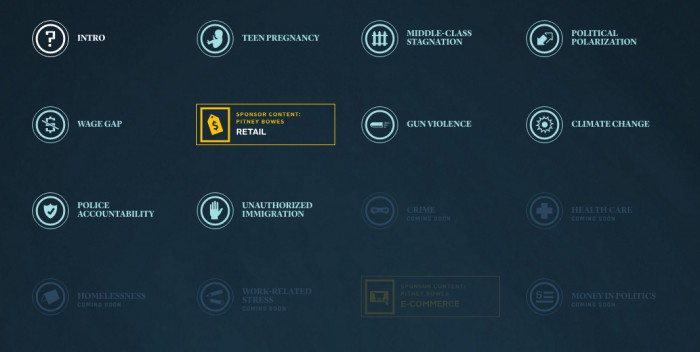
What’s the solution to gun violence in America? How do we close the wage gap in the United States? What do we do about unauthorized immigration? In an attempt to tackle these topics of national and global concern — questions that feel almost unsolvable in our current political climate — The Atlantic is experimenting with what it’s calling an inversion of the Q&A.
The site’s A&Q series offers reporters a chance to address common “answers” (assumptions, myths, widely held but unsupported conclusions) by posing questions in response that complicate those answers. Take, for example, Atlantic associate editor Robinson Meyer’s A&Q piece on climate change. (Meyer is also the founder of the climate change newsletter Not Doomed Yet, which tries to bring a little incremental nuance to a gloomy yet intangible issue.)Answer: The market will solve this problem, just like it solved expensive air travel, pre-Internet communication, and the sleeveless blanket.
Question: As Republicans try to criticize climate regulation while accepting climate science, they turn to some variant of this line. I think there are two knocks against it — one more facile than the other.
The first is that, you know, if private industry was going to step up and address the climate crisis, it maybe should have done it already. Greenland’s ice sheet is sliding toward the sea, and Miami Beach is a lost cause: Where is the market?
But worse, I think, is that this is more or less the tack that governments have chosen to take. Governments have incentivized some pathways to green energy more than others, but the world’s approach is to move some assets around — to send that “critical message to the global marketplace” — and then tell business to figure the rest out. Is that process working fast enough? Should the residents of small Pacific islands, vulnerable to sea-level rise, be satisfied with the progress of the markets?
At the moment there are eight published A&Q pieces and twelve more broad topics waiting in the wings for the A&Q treatment (refugee resettlement, terrorism, mass incarceration, encouraging entrepreneurship, and so forth). The pieces are available on a separate “dashboard” designed and built by an in-house product and development team, and are also promoted on TheAtlantic.com homepage.
“We started with the conceit. It’s a a really familiar form to play with,” Matt Thompson, deputy editor of TheAtlantic.com, told me. “Where are the interesting, unresolved, complex, nuanced questions? Then we brainstormed with several of our section editors to come up with the topics we thought presented potential questions around which to frame this, before anything was written. It was fully theoretical — we didn’t know what shape these would take, the voice of them, in what ways would they be similar to the common Q&A, in what ways would they be different. So we just asked one of our writers to take a crack at it, made a few edits, and then rolled this out to the other section editors.”
Landing on the right tone for the A&Q pieces, which are a bit chatty while maintaining authoritativeness, wasn’t easy.“What I like about this concept — and in the editorial process, it can be hard to pull off — is the tone of the pieces,” said Catherine Green, a senior associate editor who was also involved in the creation of the A&Q platform. “Each issue is a totally different entry point, with elements not necessarily of myth-busting, but of pushing back a little on frequently circulated conclusions. For instance, in the gun violence post, some of the answers David Graham laid out were things you might see on Facebook from some of your friends who have really strong opinions on the issue.”
“The challenge with the A&Q format is that as a writer you’ve got to occupy two voices,” Thompson added. “If you are writing the questions and the answers, then you have to artificial dialogue with yourself, so one of the things that we’ve focused on in the editing has been to try to make sure both sides of dialogue feel as if they’re coming from a thoughtful, informed, and intelligent person, and you’re not constructing random answers.”
Readers are welcome to submit “potential answers to be excavated by our reporters,” Thompson said. (A few freelance contributors might participate down the line, but the A&Q series is mostly working with section editors and staffers.)The team is starting to get some feedback, according to Green: “I know the unauthorized immigration post really sparked a response — and I don’t mean just negative ones, there were just a lot of responses.”
Many of the forthcoming A&Qs on the remaining 12 topics are “still in flux,” Green said, and section editors and writers have plenty of freedom to continue playing with the format.
“Anytime we launch anything begins as an experiment, and so with each successive A&Q, we’ll learn a little more about the form: When it works, which aspects seem most compelling to readers,” Thompson said. “Right now, we have these 20 topics. But, certainly, there are stories I wish we had an A&Q for, but they didn’t fit into our current news cycle. I would have loved Jeff Goldberg to write one for the Iran nuclear deal, for instance.”
E-commerce company Pitney Bowes is sponsoring the A&Q series at launch. Three pieces of sponsored content, created by The Atlantic’s creative marketing group re:Think for that brand, are scattered throughout the editorial A&Qs, also following the A&Q format (the first elaborately designed sponsored page is already up). The A&Q format being tested out here will be extended in some way to a brand campaign for The Atlantic itself, which is coming later this spring.